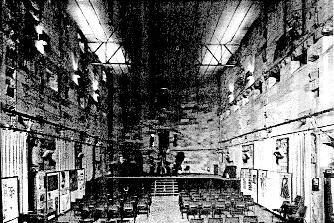Greenway chose the site for the jail. He chose this site because it's on a hill, so it was easy to see from the city. This was important because Sydney was still a convict town in 1820. The jail reminded people of this fact. It was also a good site because there was plenty of sandstone nearby for building.

The walls of the jail were built by convicts from 1822-1824. You can still see convict marks on them. The marks were made to show how many sandstone blocks each convict had cut.

Greenway's plans were used for the walls. But because he was an ex-convict, he was taken off the job and his plans for the buildings were not used. Instead, the jail was built using the plans of a jail in Philadelphia. The ideas was that it should be like a wheel. The chapel was in the centre and the cell blocks were the spokes.
Work began on the jail in 1835 and it took 50 years to finish. By 1840 the Governor's residence, one men's cell block and the women's cell block were ready. To move in, the prisoners walked through the streets of Sydney from their old jail at Circular Quay to the new jail. The first governor was the amazing Mr Henry Keck.
Read the dirty deeds of Henry Keck
The jail was built for 732 prisoners. The women's cell block was for 156 women. But in the 1850s there were as many as 450 women there. Over the years, a total of 79 people were executed at Darlinghurst Jail.
It was used as a prison from 1840 till 1912. In 1912 Long Bay Jail was opened and Darlinghurst Jail was no longer needed. But during the First World War (1914-1918) it was used as an internment camp.

The Women's Cellblock is now used as a theatre
In 1921 the site was made into a technical college. Since then the outside of the buildings have been looked after by the National Trust. The insides of the buildings were completely changed and made into classrooms.
From "A Walk with History - Darlinghurst Gaol". A loose collection of documents compiled by some previous teachers.
![]()
![]()
![]()